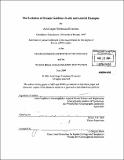The evolution of oceanic gabbros : in-situ and ancient examples
Author(s)
Kvassnes, Astri Jæger Sweetman, 1972-
DownloadFull printable version (16.13Mb)
Other Contributors
Woods Hole Oceanographic Institution.
Advisor
Henry J.B. Dick.
Terms of use
Metadata
Show full item recordAbstract
This study is a geochemical investigation into the accretion of lower oceanic crust and processes of shallow melt-rock reaction at mid-ocean ridges. Major-, trace-elements, and isotopes from whole-rocks and minerals from the Lyngen Gabbro, a 480-My old dismembered ophiolite from the Scandinavian Caledonides, indicate that this igneous complex was produced from hydrous supra-subduction zone magmas, a remnant of an incipient ocean-arc. Such ophiolites are better models for the structural evolution than the geochemical evolution of the lower oceanic crust at mid-ocean ridges. Minerals in gabbros from Atlantis Bank, Southwest Indian Ridge, a modern, in-situ example of lower ocean-crust, were analyzed for major and trace-elements. The MELTS algorithm indicates that these gabbros formed by near-fractional crystallization at mid-crustal pressures. The gabbroic crust is more evolved than the lavas and represents melts fractionated 50-95% relative to a mantle-derived melt-composition, supported by trace-element models. This argues against the often-cited gabbro-glacier accretion model, where mantle-derived melts are transported to a shallow melt-lens and fractionates there before eruption. There remain >770-m of additional primitive cumulates below 1500-m deep Hole 735B or within the underlying mantle. Thus, the seismic Moho, beneath Hole 735B, could be the crust-mantle boundary, rather than an alteration front as suggested elsewhere. The Atlantis Bank gabbros have augites that are more primitive than plagioclases and olivines with which they coexist. Melt-rock interaction, where ascending melts dissolve the pre-existing gabbroic rocks and create hybrid magma may have caused this. Dissolution-experiments for plagioclase-olivine and plagioclase-augite mineral pairs (cont.) were performed at 1180⁰-1330⁰C and 20-min - 24hrs. Dissolution occurs rapidly and out of equilibrium, with the dissolution rates dependent on the [delta]T above the solidus. Rocks with small grain-boundary areas (coarse grained or nearly mono-mineralic) heat internally when enclosed in hot magma, causing xenoliths or wall-rock to melt and disaggregate. The dissolution-derived magma crystallizes minerals more refractory-looking than the melts that precipitated the original gabbroic rocks. Assimilation of gabbroic rocks increases the Na content and decreases the Fe content of the melt that digests it, thus basaltic glasses formed after this hybridization will falsely reflect a lower degree and pressure of mantle melting.
Description
Thesis (Ph. D.)--Joint Program in Oceanography/Applied Ocean Science and Engineering (Massachusetts Institute of Technology, Dept. of Earth, Atmospheric, and Planetary Sciences; and, the Woods Hole Oceanographic Institution), 2004. Includes bibliographical references.
Date issued
2004Department
Joint Program in Oceanography/Applied Ocean Science and Engineering; Woods Hole Oceanographic Institution; Massachusetts Institute of Technology. Department of Earth, Atmospheric, and Planetary SciencesPublisher
Massachusetts Institute of Technology
Keywords
/Woods Hole Oceanographic Institution. Joint Program in Oceanography/Applied Ocean Science and Engineering., Earth, Atmospheric, and Planetary Sciences., Woods Hole Oceanographic Institution.